Accepted Scientific Name: Euphorbia enterophora Drake
Bull. Mus. Hist. Nat. (Paris) 5: 307 1899
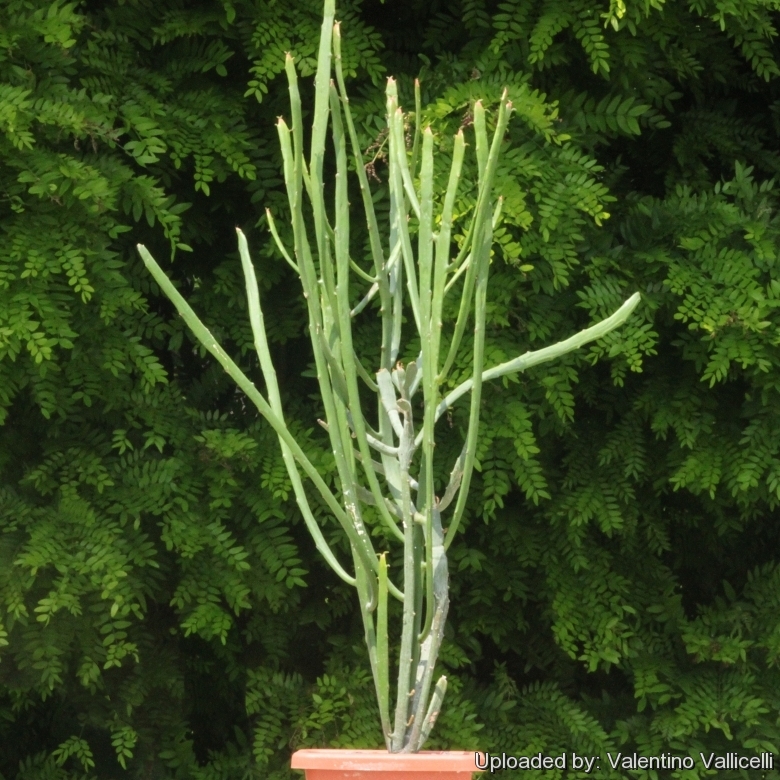
Euphorbia xylophylloides (Euphorbia enterophora) Photo by: Valentino Vallicelli
The branches or joints (a.k.a. platyclades or phylloclades) appear as flattened leaf-like growths and are compressed, ribbonlike, spineless, erect, slightly waxy and rounded at the apex, 5-22 cm long, 1-2 cm wide.
Origin and Habitat: Madagascar (Tulear to Fort-Dauphin; central Madagascar: Ihosy area, Zazafotsy) and the Comoros. The typical subspecies has a large extent of occurrence (113,423 km²) and a large area of occupancy (42,844 km²). It is recorded from 38 localities and comprises six to twelve subpopulations, but the habitat in which they occur is highly fragmented.
Habitat: Spiny forest on arid regions of south-west of Madagascar or on rocks and inselbergs of the central high plateau. Euphorbia enterophoraSN|22923]]SN|22923]] is threatened by habitat degradation, fire, habitat clearing for charcoal, collection for horticultural purposes.
Synonyms:
See all synonyms of Euphorbia enterophora
Common Names include:
ENGLISH: Milk-bush
Description: Euphorbia enterophoraSN|26570]]SN|22923]] is a 'cactoid' Euphorbia forming a large much branched shrub or even tree with with a broad crown and woody base occasionally up to 20 m tall. It grows upward at first but as it adds branches the plants sprawl laterally forming a large irregular mass. It is almost leafless and one of the few species with fleshy, flat, ribbon-like shoots reminiscent of the Christmas Cactus (Zygocactus, Epiphyllum, Phyllocactus etc.. in Cactaceae).
Remarks: This plant is also known as Euphorbia xylophylloidesSN|22923]]SN|26570]] but the original description of E. xylophylloides is incomplete and the type not preserved, and probably not a species of Euphorbia.
Stem: Main trunk and branches roundish with papery bark, often shooting from the base, irregularly branched. The lateral branches (or joints) appear as flattened, 2-angled, yellowish green, leaf-like growths (a.k.a. platyclades or phylloclades) and are compressed, ribbonlike, spineless, slightly toothed along the edges, erect, slightly waxy and rounded at the apex, 5-22 (or more) cm long, 1-2 cm wide. The tips hairy whitish (purple-maroon in subs. crassa).
Leaves: Ephemeral, ovate, 6 x 4 mm, minute only persisting for a short while on young growth and soon deciduous. Petiole 1 mm long.
Flowers(cyathia): About 4 mm in diameter, unisexual, yellowish, hairy, inconspicuous arranged in small clustered cymes at the tip of the branches. Nectar glands tiny ,brownish, quite separate. Ovary globose subsessile.
Fruits (capsules): Subglobose. Peduncle 7 mm long.
Seeds: Oblong, 5 x 3 mm, whit caruncle.
Subspecies, varieties, forms and cultivars of plants belonging to the Euphorbia enterophora group
 Euphorbia enterophora Drake: is a tree up to 10 m tall, with lateral branches flattened, 2-angled, yellowish green, leaf-like, compressed, ribbonlike, spineless. The tips hairy whitish. Distribution: Madagascar and the Comoros.
Euphorbia enterophora Drake: is a tree up to 10 m tall, with lateral branches flattened, 2-angled, yellowish green, leaf-like, compressed, ribbonlike, spineless. The tips hairy whitish. Distribution: Madagascar and the Comoros.- Euphorbia enterophora subs. crassa Cremers: is a shrub to 4 meters tall with branches slightly thicker. Branches tips, leaves and fruit red hairy. Distribution: Tolinara. Madagascar.
Bibliography: Major references and further lectures
1) Urs Eggli “Illustrated Handbook of Succulent Plants: Dicotyledons” Volume 2. Springer, 2002
2) Hermann Jacobsen "A Handbook of Succulent Plants: Abromeitiella to Euphorbia" Page 473 Blandford Press 1960
3) James Cullen, Sabina G. Knees, H. Suzanne Cubey "The European Garden Flora Flowering Plants: A Manual for the Identification of Plants Cultivated in Europe, Both Out-of-Doors and Under Glass" Cambridge University Press, 11/Aug/2011
4) Clive Innes "Complete Handbook of Cacti and Succulents" Van Nostrand Reinhold Company, 01/dic/1981
5) Haevermans, T. 2004. Euphorbia enterophora. In: IUCN 2013. IUCN Red List of Threatened Species. Version 2013.2. <www.iucnredlist.org>. Downloaded on 10 April 2014.
6) Cremers, G. “Les euphorbes coralliformes de Madagascar.” Bull. Jard. Bot. Belg 54: 23–64. 1984
7) Leandri, J. “Les arbres et grands arbustes malgaches de la famille des Euphorbiacees.” Naturaliste Malgache 4(1): 47–82. 1952
8) Leandri, J. “Euphorbiaceae.” Cat. Pl. Madag., Euphorb. 2(23): 1–51. 1935
9) Rauh, W. “Succulent and Xerophytic plants of Madagascar.” Vol I. Strawberry Press, Mill Valley.1995.
10) Rauh, W. 1998. “Succulent and Xerophytic plants of Madagascar.” Vol II. Strawberry Press, Mill Valley 1998
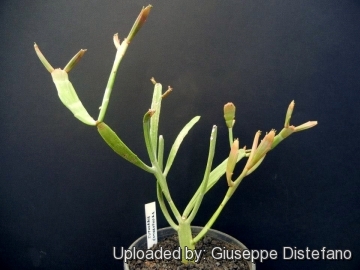 Euphorbia xylophylloides (Euphorbia enterophora) Photo by: Giuseppe Distefano
Euphorbia xylophylloides (Euphorbia enterophora) Photo by: Giuseppe Distefano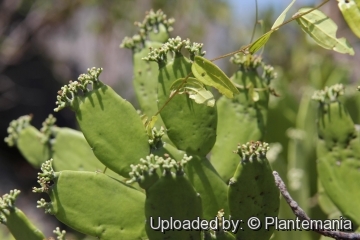 Terminal flowering stems are shorter and leaf-like often only 5 cm long. (Euphorbia enterophora) Photo by: © Plantemania
Terminal flowering stems are shorter and leaf-like often only 5 cm long. (Euphorbia enterophora) Photo by: © Plantemania Euphorbia xylophylloides (Euphorbia enterophora) Photo by: Valentino Vallicelli
Euphorbia xylophylloides (Euphorbia enterophora) Photo by: Valentino Vallicelli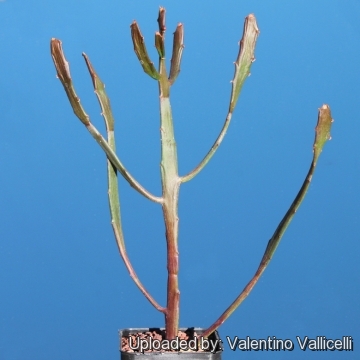 Euphorbia xylophylloides (Euphorbia enterophora) Photo by: Valentino Vallicelli
Euphorbia xylophylloides (Euphorbia enterophora) Photo by: Valentino Vallicelli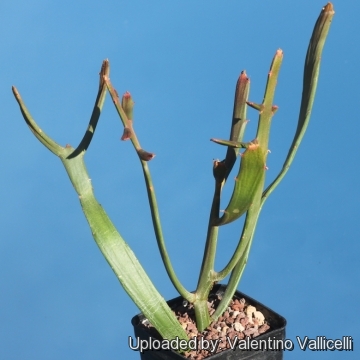 Euphorbia xylophylloides (Euphorbia enterophora) Photo by: Valentino Vallicelli
Euphorbia xylophylloides (Euphorbia enterophora) Photo by: Valentino Vallicelli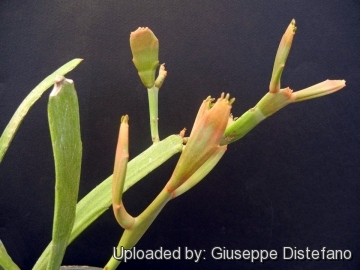 Euphorbia xylophylloides (Euphorbia enterophora) Photo by: Giuseppe Distefano
Euphorbia xylophylloides (Euphorbia enterophora) Photo by: Giuseppe Distefano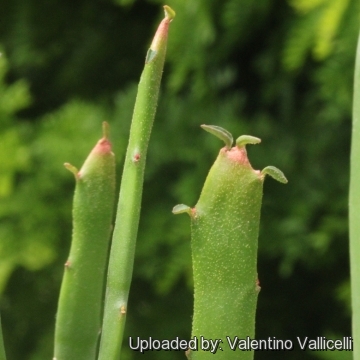 Euphorbia xylophylloides (Euphorbia enterophora) Photo by: Valentino Vallicelli
Euphorbia xylophylloides (Euphorbia enterophora) Photo by: Valentino VallicelliSend a photo of this plant.The gallery now contains thousands of pictures, however it is possible to do even more. We are, of course, seeking photos of species not yet shown in the gallery but not only that, we are also looking for better pictures than those already present.
Read More... Cultivation and Propagation: It is an easy species to grow that is suited for a hot dry spot in the garden. But young plant are happy growing indoors in a decorative pot. Give the plant an airy growing medium which mainly consists of non organic material such us clay, pumice, lava grit, and only a little peat or leaf-mould. Water regularly during the active growing season from March to September. No water should ever be allowed to stand around the roots. Keep almost completely dry in winter. If plant becomes reddish, this is a sign that the roots have not developed properly. It is a relatively fast growing and long lived plant and once established, it will be content in its position and with its soil for years. It can tolerate moderate shade, and a plant that has been growing in shade should be slowly hardened off before placing it in full sun as the plant will be severely scorched if moved too suddenly from shade into sun. Like quite small pots, repott in very later winter, early spring. Can be pruned for shape and branching.
Frost tollerance: Frost tender, it can withstand temperatures only above 2º C.
Pests and diseases: It is prone to mealy bugs and rarely scale.
Propagation: It is easy to propagate by cuttings in late spring to summer, just take a cutting of the plant dip it in rooting hormone, allow it dry for for a week prior to planting in the ground (preferably dry, loose, extremely well draining soil).
Warning: All parts of Euphorbias ooze a milky sap when damaged or cut. Contact with this sap may cause dermatitis in some people, and in the eyes the sap can cause temporary blindness which may last for several days.

















